L.A. Noire,the first and last collaboration between nigh-bankrupt Australian studio Team Bondi and big-name publisher of the Grand Theft Auto franchise, Rockstar Games, was finally released for PC last week, after launching with fanfare for consoles back in the spring.
The PC release seems like a good time to take a fresh look at the game, since it plays a lot more like an old-school PC title than a contemporary high-budget thriller, despite all the driving, shooting, fighting, mature themes and optional free-roaming.
In case you haven’t played it, here’s a video walkthrough of the first full mission for reference (spoilers for very early on in L.A. Noire):
There are a lot of detective games with arcade elements, but the game it most directly recalls for me, because of its aesthetic, painstaking attention to detail, focus on story, and the way it handles linear gameplay, is the 1997 Blade Runner detective game for PC by Westwood Studios (spoilers for the first mission of a game from 14 years ago):
Games like this have a few qualities that can seem foreign to players with expectations built around the larger body of video games — chief among them that the story progresses whether you do well or poorly, and you can play the game through to the end with only minor variations even if you get a whole lot of stuff wrong. This is very strange to gamers primarily influenced by The Legend of Zelda and its legacy (that is, most commercial video games) — where, even when a game is complex and open-ended, finishing it requires you, at least for the main storyline, to get everything right.
This latter way of playing has become second-nature to gamers, which says a lot about how video games have affected our psychology and shaped the way we look at the world, for better or worse.
More investigation, after the jump…
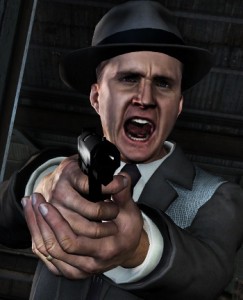
"Get on that GODDAMNED couch, so I can METHODICALLY QUESTION you!"
Picking the gum off my shoe
There are a few ways to play L.A. Noire:
- Do your best on the fly, looking for clues at crime scenes and making your best guesses, maybe taking advantage of the in-game help, but mostly just playing at the pace of the story to get to the next cutscene.
- Read or watch walkthroughs and do the things they tell you to get five stars on every mission.
- Puzzle out the specifics of the cases, which can be surprisingly time-consuming and require a whole lot of attention to detail.
- Focus on reading the characters’ faces and gestures, and use that to guide you through interrogations, rather than the evidence.
- Brute-force everything, clicking on everything in every search and restarting each interrogation over and over again until you get it right.
- Dick around, free-roam and do side quests and stuff.
Despite its Grand Theft Auto shell, dicking around isn’t as much of a focus in L.A. Noire as in similar games. As a police officer, you’re strongly discouraged from hurting innocent people, except when it serves as a dark reminder of the moral failings rotting out the utopian aspirations of postwar America (in which case, go crazy-go-nuts).
No, the LAPD doesn’t like you hitting people with you car. That takes a lot of the fun out of the signature feature of Grand Theft Auto games, which is driving around hitting people with your car. What, that isn’t why you play? Moving on.
The other options, though they will change the specifics of what you see and hear, will all more or less get you through the story. Sure, you get a star rating on every mission, which is some incentive to get things “right.” There are achievements, and who doesn’t love those? But these things don’t matter that much. It feels more like you’re playing a movie than a game, except when you run into the pernicious challenges that don’t yield to the conventional wisdom and playstyle of the greater body of video games — and the notable absence of “retry” on the interrogations.
The Video Game Value of Work
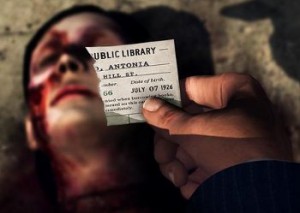
The most important thing in this image? The half an address.
The thing that surprises me the most about L.A. Noire is how badly brute forcing works.
(I learned about brute forcing from the A.I. menu of Chessmaster 3000, the 1000 better sequel to the then-futuristically named Chessmaster 2000 — which was in turn 100 not as good as Chessmaster 2100. But all that isn’t important right now.)
Brute forcing means trying every possible solution to a problem in a systematic way, knowing that one of them will eventually work — like trying all the numbers from 1111 through 9999 to open a bike lock, hoping everybody around you ignores you or thinks you are absurdly forgetful. Most locking and password systems are designed to make brute forcing difficult. It is one of the most time-consuming ways to solve a problem. It is an absurd way to buy shoes at DSW, for example, where the sizes and styles overwhelm even the most powerful supercomputers.
But in video games, brute forcing is almost guaranteed to work — rather than a problematic chore for cryptologists, it has become the major driving force behind playing most games, ostensibly for fun. Let’s act like algorithms for a few hours until dinner-time. Ah, leisure!
The real touchstone of brute forcing as leisure, which has influenced all others, was The Legend of Zelda. Zelda expected you to push every stone in the world in the hope it might move, detonate explosives everywhere in the hopes the terrain would decide to open for you (and the trust that, if it would be detrimental, it wouldn’t open), literally try to burn down every tree in the forest in the hopes of finding hidden money, and walk into every blank wall in the hopes you might arbitrarily go through it.
To me, Level 7 of the first quest of Zelda is where this notion took root — that you need to approach problems with the attitude of trying every possible thing, relying on the world around you to let you know whether you are right rather than your own intuition. Well before everybody used the Internet, word of mouth and word of Nintendo Power spread the truth of Level 7 — without it, even finding the level might have been unreasonable. Count the number of total dick moves the game pulls on the player in this walkthrough of the dungeon (from zeldanavigator‘s YouTube Channel):
http://www.youtube.com/watch?v=1SKnZxZuWyA
First, you have to blow a whistle by a lake to dry up the water to get into the dungeon, in a game where textual help is sparse and cryptic and where whistles don’t generally dry up water as a matter of course. In the room where you get the map of the dungeon, the first thing to do is try to blow up the blank wall on the north side, which the map you just got clearly tells you goes nowhere. A room or two over from that, you need to bomb another blank wall, which the recently acquired and now thoroughly useless map erroneously tells you goes nowhere. Then of course you have to kill absolutely everything in the room before pushing an arbitrary block to go get an item you really don’t need, but which you are conditioned to find in every dungeon. Throughout, you nonchalantly fight a variety of monsters who are invincible until you brute force the right item to use, which is usually counterintuitive, at which point they become easy.
If this all feels normal to you, you’re not alone. It feels normal to me. I know by default to kill everything in a room before pushing on every fixed structure in order to see if I get an item I don’t really care if I need. It just happens automatically. It’s what I do at Chipotle most of the time.
The Flatfoot of Menlo Park
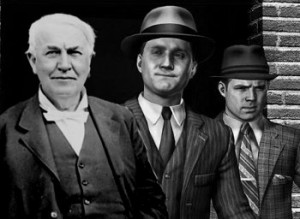
Wearing suits like that in L.A. in the summer? No wonder you perspire so much.
It might even feel scientific — it is, after all, how Edison found a commercially viable material for the filament for incandescent light bulbs, right? He famously tried everything from platinum to elephant skin.
The difference, though, is that Edison expanded on the work of the people who came before him, he didn’t start fresh assuming everything he was told was wrong. When somebody handed Edison a map, his first impulse wasn’t to throw it out — but to use it. A lot of Edison’s work was brute-force-ish, but the man knew how to hypothesize, and he knew how to use existing information.
The human mind seems predisposed to brute force thinking as a way of figuring out what is good to eat or safe to do — we try something, it kills somebody we love, we get a huge aversion to it and never try it again, and we write that down in meter and rhyme so we remember it and pass it down to future generations. Kosher and Halal laws are mostly this — records of good judgement drawn from experience, which is drawn from bad judgement. Don’t eat shellfish, because it can kill you. Understanding Red Tide isn’t important when you’re brute-forcing dinner options.
In that way, all of humanity, and indeed all of life, is a brute-force experiment — except, again, we are well-advised to follow patterns rather than assume what we already know is always wrong. And we don’t just remember the specific things that hurt us, we are drawn to patterns or themes, building into our ancestral stories and wisdom, as well as into our own emotional memories, guidelines and rules of thumb that will hopefully help others make better decisions in the future when they encounter situations that may or may not be new to the species.
In many video games, these two skills — the skill to figure out which guesses are reasonable, and the skill to build on the information you already have about a situation — aren’t just useless, they are actively counterproductive. A lot of the challenge in video games comes from the designers and developers picking smart moments to defy your expectations, prompting you to try the thing that you know isn’t supposed to work — to the point that players are conditioned it might be the best way to approach every problem. Perhaps it has contributed to a generation of contrarian curmudgeons who immediately look to what is wrong with any situation — which isn’t the worst point of view on things, but maybe isn’t always the best.
The real break with reality, though, far worse than what video games ask us to give up, is what they give us in return. They don’t just condition us to think it is stupid to analyze existing evidence to formulate a hypothesis, they convince you that if just work on something, even if you do it automatically and without critical self-awareness, even if that something that seems entirely useless by all your better judgement, the universe will reward you by eventually telling you that you are right.
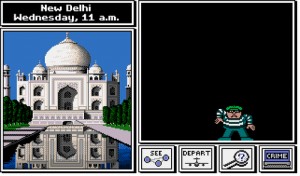
Fancy meeting you here. Now tell me, where is the Eiffel Tower? And does the person who stole it like spelunking?
This is, unfortunately, not how the world works. There are spare few rewards for spinning your wheels with no plan as to how to succeed. The universe doesn’t drop flower pots on your head to let you know a V.I.L.E. henchman is around — you can rarely be so certain you are on the right track. Just see what kind of value you get out of opening every drawer in your office looking for secret papers, rather than asking the other people who work there what the most efficient way is to get what you need. And then ask yourself why you work in an office.
Oh, it’s useful to know how to brute force — even in L.A. Noire, a lot of problems yield to persistence, and it’s valuable to have a mindset available that can tolerate that kind of work when it is necessary. But even when you do find the answer, you need to be able to recognize it on your own. There is no chime that rings to let you know the doors have all opened and that pushing the third block from the left will now (and only now) open the way to the silver arrows.
Shamus and the splash zone
One discovery I made playing L.A. Noire was this way of thinking had entrenched itself in my mind to a much greater degree than I ever thought possible — being forced to pick a right answer without trying all the options in a video game has become physically uncomfortable. I want to click on everything. I want to try every option. By default, I don’t trust any of the knowledge I have about the situation, expect the game to try to trick me, and would prefer to walk around every scene in a systematic, looping pattern, clicking constantly, and follow that up by asking every witness every question and demanding every possible response.
However, despite the opportunity to replay the action sequences as much as you want without the burden of “hit points,” “lives,” or “permanent consequences to being shot in the face,” (and a bunch of other more familiar video-game stuff that has been sewn into this game to make it familiar like an Inception car chase) in L.A. Noire, replaying the interrogations is discouraged. You don’t get to go back and try other avenues of inquiry if a suspect reacts poorly to a threat — you deal with the consequences of whether you believed what the suspect said or not, and you move on.
To try an individual interrogation again, you have to quit the game, go back to the loading screen, then the title screen, then resume and back to a loading screen then back to your last automatic save point, all before you hit a different automatic save point. You’re welcome to replay the missions from the beginning as many times as you want, but each interrogation is meant to stand on its own, not giving you the option of brute-forcing.
Even in the old-school Sierra games, distant cousins of L.A. Noire many times removed, you are encouraged to click on everything, and if you click on the wrong thing and die, you just start over from fairly recently and click on everything again.
The first time I realized I couldn’t go back and click on something else in L.A. Noire was a bit of a shock. It was a far greater shock when I realized it never told you what the right answer was supposed to be, even if you used intuition points (the finite amount of in-game help you get, which you can increase at a faster-than-normal rate through aforementioned dicking around with side quests whilst refraining from hitting people with your car).
This all shouldn’t be so shocking, because that is how it works in life. If you get something wrong, you don’t get told the right answer, and you don’t necessarily always get to try again.
And it’s not like clicking on the wrong thing makes you lose — you usually just suffer some minor penalty that will hit your star rating at the end of the mission but otherwise doesn’t stop the game from moving forward. The bad guy will still get caught, and whether it’s the right bad guy or not won’t depend much on you, most of the time. Things move on, and if it weren’t for the little “X” next to the question, you might never know you were incorrect.
It’s a far cry from a game that kills you over and over unless you position a bunch of mirrors in exactly the right order to direct the sunlight to a hidden switch. Well, L.A. Noire has that sort of stuff too, but it’s not the real meat of the game.
Where do you want to go today, Phelps?
The social force exerted by this sort of presumption urges us to see work in itself, independently of its wisdom or product, as a solution for problems and source of redemption — brute-force video gaming could potentially be seen as a technology of power, by which institutions strengthen their ability to make us work. They train and induce us to try and try and try in ways that would otherwise not be ideal for our own well-being.
I read somewhere — might have been in Michael Pollan — that the classic Microsoft slogan, “Where do you want to go today?” carries a huge presumption: that people ought to always want to go somewhere or do something, and it is never okay to be static or unproductive. This is admirable after a fashion, but there are ways in which it hurts us.
For me, it made me rush through cases in L.A. Noire, missing fine details, and not even realizing I’m supposed to be comparing addresses on automobile pink slips and watching for discrepancies in record books before I even start the interrogations.
Notably, I am not done with L.A. Noire yet (only just started on the Vice desk – impressed at how long this game is!), so perhaps it will change, but it already feels different from many games, and it’s unfortunate Bondi and Rockstar won’t collaborate again.
It is a mark to L.A. Noire’s credit that one way it feels most old-fashioned is in the very processes by which it plays — it really feels like analog, pavement-pounding, early-in-the-season-of-The-Wire detective work. Because in the City of Angels, human life is cheap, but the marriage of form and function in a solid product design, well, that’s worth killing for.
Or fifty bucks on Steam…
::jazzy terror chord::
Thoughts on this subject, or on games that exemplify one side or another of it? Sound off in the comments!
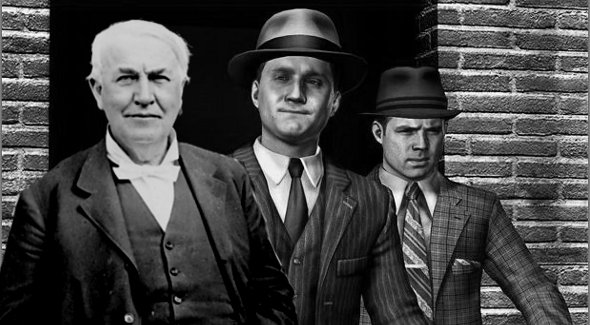
Also, big ups to Graham Norris, whom I knew from Latin class and theatre in college, and who pops up in this game a few times as various characters. Unfortunately at some point I think the game made me shoot him. Sorry about that, Graham.
I saw an article on the BBC site that made me think about this post:
http://www.bbc.co.uk/news/health-15720178
“The brains of people who regularly play computer games differ from those of infrequent gamers, research suggests.
“A study in teenagers showed the “reward hub”, which is involved in addiction, was larger in regular players.”
I wonder if the type of counter-intuitive reward-finding, vs the more intuitive but railroading style has to do with this type of difference?
I think the goal of game design is to discourage brute force solutions. In later iterations of the Zelda franchise there are far more visual cues associated with what items will work where. The first time you get bombs you’ll be put in a room with no exits, but a boulder against one wall that sticks out like a sore thumb. Now you know to associate boulders with bombs. If you are rubbing up against every wall you are doing it wrong.
The developers know that if you are stuck for more than X minutes you’re just going to look up the answer. They are playing a sort of meta-game against you to make sure you are stuck long enough that you feel clever when you do get the answer but not so long that you go to the collective brute forcing power of the internet.
It’s telling that L.A. Noir takes such pains to keep you from brute forcing the interview process. They know there’s is a predisposition for that and they have to train you to not do so.
There’s a commentary track to the game Portal that talks a lot about training the player as well.
I want to (a bit belatedly) get into this discussion, because I played this game too. At first I was intrigued by the idea of a game that was focused less on reflexes and more on plot, logic, and intuition. But I quickly found that the gameplay just wasn’t that interesting to me. For some of the game, you wander around a crime scene waiting for your controller to vibrate. In other parts, you get to ask questions. But you pretty much get the same info whatever you choose, and (more frustratingly) you never learn what you did wrong. There’s some driving, but nothing challenging and nothing you can’t skip by letting your partner take the wheel.
Basically, this game does not want to be a game. It wants to be a movie. That’s why it was entered in a film festival:
http://techland.time.com/2011/03/29/l-a-noire-becomes-first-video-game-ever-featured-at-tribeca-film-festival/
Here are some things you CANNOT do in L.A. Noire:
Pick the cases you want to take
Control your own career path
Take your girl out on a date
Take on private detective missions on the side
Turn rogue and secretly work for the mafia
Take pictures of celebrities outside their mansions and sell them to tabloids
LA doesn’t feel like a whole world for you to explore. You have only one or two destinations you’re allowed to go to at any given moment. This is not a sandbox. This is not an open world. It’s a series of pre-scripted stories that you advance through linearly, regardless of how well or poorly you do. That may fun for some people, but it’s not my cup of tea.
I agree mostly with your points, but I would like to put forth Skyrim as an example of a counter, where it is a completely open world where you can do anything, but nothing you do matters — you can save the world and no one really reacts; you can kill (almost) anyone and…well, no one really reacts. There’s so much to do, but none of it really has the weight of a story that moves forward, because the world itself doesn’t ever respond. It’s still a good game — much like I would say L.A. Noire is — despite its flaws.